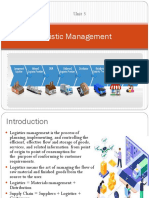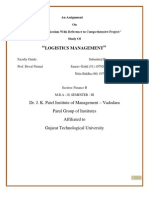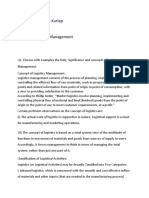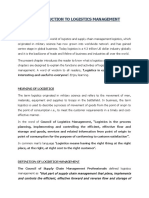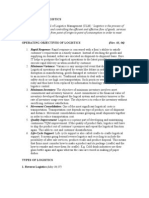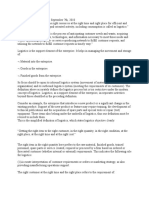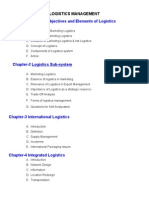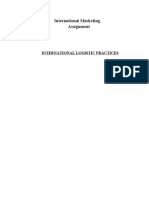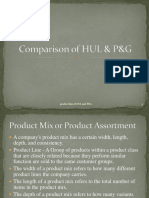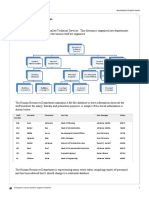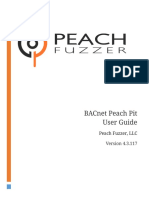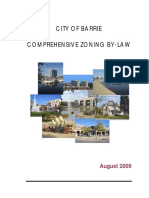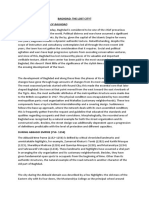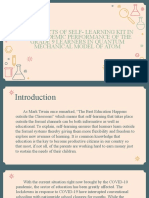Logistics 1.7 1.8
Logistics 1.7 1.8
Uploaded by
Mia KhalifaCopyright:
Available Formats
Logistics 1.7 1.8
Logistics 1.7 1.8
Uploaded by
Mia KhalifaOriginal Description:
Original Title
Copyright
Available Formats
Share this document
Did you find this document useful?
Is this content inappropriate?
Copyright:
Available Formats
Logistics 1.7 1.8
Logistics 1.7 1.8
Uploaded by
Mia KhalifaCopyright:
Available Formats
1.
7 INTEGRATED LOGISTICS
Introduction:
Integrated logistics is a technique which utilises various source and
Channels to meet customer demand in time. Logistics is viewed as a
Competency that links an enterprise with its customers and suppliers.
Information from the customers flows in the form in the form of sales
Activity, forecasts and orders. Information is then translated into
Manufacturing and purchasing plans. Raw materials are procured and
Converted into finished products. Thus, the process is viewed in terms of two
Inter-related efforts, inventory flow and information flow.
The entire logistical process is viewed in terms of two inter- related
Activities. They are:-
a. Inventory Flow
b. Information Flow
a)Inventory Flow:-
1. The operations of logistics starts with a purchase of raw material
From supplier and ends when this raw material is converted into a
Finished Product sold to customers.
2)This raw material gets value at each stage of its development.
Stages of Inventory Flow:-
1. Procurement:- It basically involves purchase of raw material for
The finished product.
2. Manufacturing Support:- It basically involves performing
Various manufacturing activities and operations to convert raw
Material into a finished product.
3. Physical Distribution: It basically involves movement of
Finished goods towards the customers for utilization of value
Created.
b. Information Flow..
Logistical Information Flow involves two major types of flows:-
I )Planning and Co-ordination flows:-It provides information concerned with planned activities.
ii) Operations Flow:- It is needed to direct day to day activities.
Information flow is on both the directions. Information flows from
Customers in relation to their needs, wants, preferences, etc.
Information also flows within the various units of the organization
Such as manufacturing plant, warehouse, etc.
1.8 LOGISTICAL COMPETENCY
Introduction
1)The two main objectives of logistics are:
a) To minimise overall logistics costs.
b)To provide superior customer service.
2. But the problem is that if company attempts to provide superior
Customer service, then logistical cost will increase. In the same manner,
If the company attempts to reduce overall logistical costs, then customer
Service is not satisfactory.
3. Thus, a company has to maintain a proper balance between its two
Main objectives so as to provide superior customer service at a lower
Logistical cost. This is possible through a proper logistical competency.
4. Thus, logistical competency is the arms capability to provide superior
Customer service at lowest possible cost.
5. Its arms is to exploit logistical function to provide superior customer
Service at lowest cost in order to gain market share.
6. In a tour made by product from raw material stage (supplier) to the
Manufacturing firm, from manufacturing firm to the point of
Consumption such as transportation, warehousing, material handling,
Inventory management, etc are performed.
7. The WORK OF LOGISTICS is to co-ordinate functional areas like
La transportation, warehousing, material handling, etc into Network Design
To achieve logistical competency.
Devlopement to logistical competency
Market leader
State 4
Customer service
State 3
Market access
State 2
Gaining cost Effectiveness
State 1
SEVEN PILLARS / SEVEN PARAMETERS to achieve logistical competency.
1. Network Design: Logistical network includes various facilities such as
Manufacturing plants, warehouses, distribution centres and retail stores.
Logistical network analysis involves:
1)Determining which facilities are needed (Plants, warehouse,Distribution centres).
2)Determining how many of each type of facility. (number of plants,warehouses, distribution centres)
are needed.
3)Determining the geographical location of each facility.
4)Determining the work to be performed at each facility.
All this analysis of various facilities is known as Logistical Network
Analysis.
Proper network analysis will result in establishing an appropriate
Network design which will reduce overall logistical costs but yet provide
Superior customer service.
2. Information Management: Information Management is a invisible
Element in the process of logistical management. Information plays a
Crucial role in the process of logistics management. Demand
Forecasting and order processing are two areas of logistical work that
Depends on information. Timely information and accurate data are the
Key to the better logistical performance.
3. Transportation: Transportation refers to physical movement of
Products from one place to another. Since products are produced in a
Different area and are consumed in a different area, transportation
Physically moves the products from where they are produced to where
They are needed. It acts as a physical link that connects the company to
Its suppliers and customers.
Transportation is accomplished in three ways:
One’s own fleet- Private carriage borbe include albed
Contract with specialists on long term basis-contract carriage
Contract on individual shipment basis- common carriage
Determinants of effective transport system
Cost: The cost refers to total cost for the movement of goods between
The two geographical functions and expenses related to administration
And maintaining in-transit inventory.
Speed: Speed of transportation refers to the speed with which goods
Reach the destination.
Consistency: Consistency in speed means achieving the same speed
Over a long period of time.
Logistical competency can be achieved by deciding proper mode of
Transportation, deciding number and size of transport facilities, deciding
Delivery routes to be followed, etc.
4. Inventory Management: Inventory management involves maintaining
The required level of stocks to meet customer requirements
Altaneously ensuring minimum inventory carrying cost. Inventory
Management involves decision to be taken on various aspects such as:
Safety Stock
Lead Time
Replenishment of stock
Logistical competency can be achieved by accurate sales forecasting,
Efficient order management, stock control, etc.
5. Warehousing, Material Handling & Packaging:
Warehousing: Warehousing is a storage place where goods are
Stored until they are sold. Thus, warehousing is basically holding
Goods before dispatch after it is produced.
Logistical competency can be achieved by deciding number of
Warehouses, location of warehouses, types of warehouses, offering
Specialized services, etc.
6. Material Handling: Material handling means providing the right
Amount of right material, in the right condition, at the right place, at the
Right time.
Logistical competency can be achieved by deciding the type of material
Handling equipment, scheduling material handling activities and proper
Maintenance equipment.
7. Packaging: Packaging is an important logistical management function.
It has a significant impact on the cost and productivity of the logistical
System. Packaging influences both the efficiency and the effectiveness
Of logistical operations.
Basically, there are two types of packaging: Consumer packaging and
Logistical packaging.
Consumer packaging
Focus customer convenience, market appeal and product protection.
Logistical packaging includes individual units, master cartons and containers. It
Focuses on handling, protection and communication. Logistical
Competency can be achieved by decided proper type of packaging.
You might also like
- Great Writing 5 (5th Edition) : From Great Essays To Research - Answer KeyDocument17 pagesGreat Writing 5 (5th Edition) : From Great Essays To Research - Answer KeyVu Dang77% (26)
- Logistic Management: Unit 3Document23 pagesLogistic Management: Unit 3Akhil Crasta100% (1)
- Logistic NotesDocument16 pagesLogistic NotesFatima AliNo ratings yet
- Ethics Short QuestionsDocument32 pagesEthics Short QuestionsM Usman RiazNo ratings yet
- All For Love Chords by HillsongsDocument14 pagesAll For Love Chords by Hillsongsmike_steven12No ratings yet
- Logistics Principles Functions and TypesDocument4 pagesLogistics Principles Functions and TypesMuchaelNo ratings yet
- Unit 1logistics ManagementDocument13 pagesUnit 1logistics ManagementSidhu boiiNo ratings yet
- Logistics Management PJT GLS VS VRJDocument20 pagesLogistics Management PJT GLS VS VRJSHABNAMH HASANNo ratings yet
- International BusinessDocument66 pagesInternational BusinessHarpal Singh MassanNo ratings yet
- Introduction To Logistics ManagementDocument27 pagesIntroduction To Logistics ManagementFaisal Tanwar100% (4)
- SCM Unit-2Document22 pagesSCM Unit-2Aashish Singh IINo ratings yet
- FLO201FDocument49 pagesFLO201FTuấn BáchNo ratings yet
- Logistics ManagementDocument16 pagesLogistics ManagementMohdNadeemAnsari100% (4)
- Indian Logistics IndustryDocument79 pagesIndian Logistics IndustryMOHITKOLLINo ratings yet
- Marketing Management Module Iv Part I: Prof - Dr.Leeba Babu Mar Gregorios College of Law Mar Ivanios Vidya NagarDocument25 pagesMarketing Management Module Iv Part I: Prof - Dr.Leeba Babu Mar Gregorios College of Law Mar Ivanios Vidya NagarAbhiram S DNo ratings yet
- Unit 4 Logistics ManagementDocument6 pagesUnit 4 Logistics Managementadityasaraswat704No ratings yet
- Supply chain ConceptDocument16 pagesSupply chain ConceptUP 16 GhaziabadNo ratings yet
- CHAPTER 3 (Notes)Document6 pagesCHAPTER 3 (Notes)Dunga Mathonsi-JuniorNo ratings yet
- Logistics ManagementDocument16 pagesLogistics ManagementsmtbnmNo ratings yet
- Ritesh Kurlap Logistics ManagementDocument17 pagesRitesh Kurlap Logistics ManagementVikas DubeNo ratings yet
- Unit 3 I.logisticsDocument14 pagesUnit 3 I.logisticsBeverly Diane P. De Luna-AngioNo ratings yet
- Supply Chain Management 22Document17 pagesSupply Chain Management 22mussamhsNo ratings yet
- Logistics and Supply Chain Management MCQ'sDocument3 pagesLogistics and Supply Chain Management MCQ'sOswin Dsouza100% (1)
- introduction to logistics management pdfDocument65 pagesintroduction to logistics management pdfphyscokoobraNo ratings yet
- LSCM CHP 1 NotesDocument77 pagesLSCM CHP 1 Notesaniket.anavkar030No ratings yet
- LSCM 2Document39 pagesLSCM 2channel.yt.first.2024No ratings yet
- Concept of LogisticsDocument38 pagesConcept of LogisticsSoham100% (1)
- Chapter - 1 Introduction To Logistics ManagementDocument38 pagesChapter - 1 Introduction To Logistics ManagementShruti100% (2)
- Unit1Document28 pagesUnit1rahulparoche251No ratings yet
- Repaso Final LogisticaDocument9 pagesRepaso Final Logisticaaaxel0702No ratings yet
- Unit-4 Physical Distribution SystemDocument28 pagesUnit-4 Physical Distribution SystemSTEVEN OMARYNo ratings yet
- Definition of LogisticsDocument31 pagesDefinition of LogisticsArun Narayanan100% (1)
- Definition of LogisticsDocument44 pagesDefinition of LogisticsPooja TripathiNo ratings yet
- Chapter Three: Logistics and SCMDocument22 pagesChapter Three: Logistics and SCMbahreabdellaNo ratings yet
- Logistics AnswersDocument23 pagesLogistics AnswersSagar NankaniNo ratings yet
- Supply Chain Management Mba (MM) Iii SemDocument55 pagesSupply Chain Management Mba (MM) Iii SemAbhijeet SinghNo ratings yet
- Logistics Mgt.-Lesson 1Document7 pagesLogistics Mgt.-Lesson 1marianbuenaventura03100% (1)
- Introduction To LogisticsDocument38 pagesIntroduction To LogisticsVivekanand Singh100% (1)
- LogisticsDocument4 pagesLogisticsvasquezjohn0829No ratings yet
- BBR510 - Warehouse ManagementDocument8 pagesBBR510 - Warehouse ManagementSimanta KalitaNo ratings yet
- Logistics PlanningDocument20 pagesLogistics PlanningJoginder GrewalNo ratings yet
- Elements of Logistics Management NotesDocument59 pagesElements of Logistics Management Notesaksr27100% (5)
- Assignment - Chapter 1.docx Without SolutionDocument3 pagesAssignment - Chapter 1.docx Without SolutionSharif EisaNo ratings yet
- logistics and SCM questions bank unit 2Document30 pageslogistics and SCM questions bank unit 222b258.srivarshiniNo ratings yet
- Introduction To LogisticsDocument4 pagesIntroduction To LogisticsMuchaelNo ratings yet
- A) LogisticsDocument5 pagesA) Logisticsmichaelurassa666No ratings yet
- Chapter 2 Components of Distribution Management (B)Document16 pagesChapter 2 Components of Distribution Management (B)muhdfirdausNo ratings yet
- Logistics MGTDocument28 pagesLogistics MGTJanmejai Bhargava100% (3)
- Activity 3Document2 pagesActivity 3Steffane Mae SasutilNo ratings yet
- Lecture 1 Logistics MGTDocument3 pagesLecture 1 Logistics MGTLiezel RamosNo ratings yet
- BVC 1-3 ChapterDocument62 pagesBVC 1-3 ChapterJyothi RameshNo ratings yet
- International Marketing MixDocument16 pagesInternational Marketing MixPriyanshu KalkhudiyaNo ratings yet
- Organization For Materials ManagementDocument60 pagesOrganization For Materials ManagementNaushad PulikkandyNo ratings yet
- International Logistics ManagementDocument8 pagesInternational Logistics ManagementAby M DominicNo ratings yet
- GU 01 Physical Distribution OverviewDocument4 pagesGU 01 Physical Distribution OverviewTanmayNo ratings yet
- Projects of DHLDocument43 pagesProjects of DHLkamleshNo ratings yet
- Logistic Planning: Logistics Is Generally The Detailed Organization and ImplementationDocument7 pagesLogistic Planning: Logistics Is Generally The Detailed Organization and ImplementationHarshit AgrawalNo ratings yet
- Logistics ManagementDocument53 pagesLogistics Managementkarandeep89No ratings yet
- Financial Impact and Operational Function in Logistic BusinessDocument94 pagesFinancial Impact and Operational Function in Logistic BusinessNilesh VadherNo ratings yet
- Course PowerpointDocument58 pagesCourse Powerpointmoges lakeNo ratings yet
- International Marketing AssignmentDocument19 pagesInternational Marketing Assignmentavina1111No ratings yet
- Logistics AssignmentDocument22 pagesLogistics AssignmentKalp DoshiNo ratings yet
- Procedure and Documentation in Supply Chain Management: Business strategy books, #1From EverandProcedure and Documentation in Supply Chain Management: Business strategy books, #1No ratings yet
- Logistics 7 8 9Document1 pageLogistics 7 8 9Mia KhalifaNo ratings yet
- BRM ImptDocument6 pagesBRM ImptMia KhalifaNo ratings yet
- Mobile Student Login DemoDocument17 pagesMobile Student Login DemoMia KhalifaNo ratings yet
- Online Teaching & Learning TIME-TABLE 2020 - 2021: Name of Class Coordinator DR - Abhilasha Magar Departme BBIDocument21 pagesOnline Teaching & Learning TIME-TABLE 2020 - 2021: Name of Class Coordinator DR - Abhilasha Magar Departme BBIMia KhalifaNo ratings yet
- Logistics Objectives Chapter 1 - 3Document3 pagesLogistics Objectives Chapter 1 - 3Mia KhalifaNo ratings yet
- 1.1 To 1.6Document47 pages1.1 To 1.6Mia KhalifaNo ratings yet
- Comparison of HUL P GDocument8 pagesComparison of HUL P GMia KhalifaNo ratings yet
- SDM 66 To 71Document8 pagesSDM 66 To 71Mia KhalifaNo ratings yet
- Comparison of HUL P GDocument8 pagesComparison of HUL P GMia KhalifaNo ratings yet
- MarketingDocument2 pagesMarketingMia KhalifaNo ratings yet
- Services Marketing BookDocument314 pagesServices Marketing BookMia KhalifaNo ratings yet
- Brand Management Unit 2Document12 pagesBrand Management Unit 2Mia KhalifaNo ratings yet
- Consolidated Statement of Financial Position: (With Comparative Fugures For CY 2016)Document6 pagesConsolidated Statement of Financial Position: (With Comparative Fugures For CY 2016)Alicia NhsNo ratings yet
- Paper 2 - Option A - Databases SL/HL Core: Annotated Student Work Paper 2: Example 1Document9 pagesPaper 2 - Option A - Databases SL/HL Core: Annotated Student Work Paper 2: Example 1anirudhNo ratings yet
- Adobe Scan 23 Mar 2023 - 101759Document9 pagesAdobe Scan 23 Mar 2023 - 101759Sidharth Kashyap BorthakurNo ratings yet
- Upload Test NewDocument7 pagesUpload Test NewKaranNo ratings yet
- Final Schedule of The ETE For Autumn Semester 2024-2025Document86 pagesFinal Schedule of The ETE For Autumn Semester 2024-2025amrit030201No ratings yet
- Microsoft Access 2: Database Creation and ManagementDocument30 pagesMicrosoft Access 2: Database Creation and ManagementJeff SkylerNo ratings yet
- Bacnet Peach Pit User GuideDocument11 pagesBacnet Peach Pit User Guide许昆No ratings yet
- Digital Bulletin: Media KitDocument15 pagesDigital Bulletin: Media KitjhhhhNo ratings yet
- Urban GardeningDocument28 pagesUrban GardeningENANO Jayryl D.No ratings yet
- Barrie Zoning By-Law 2009-141 120413 PDFDocument159 pagesBarrie Zoning By-Law 2009-141 120413 PDFSalsa_Picante_BabyNo ratings yet
- DHTM-106 SLMDocument196 pagesDHTM-106 SLMAYUNo ratings yet
- Auto QtyDocument36 pagesAuto QtyKhan Muhammad AkramNo ratings yet
- Sample Safety Risk Assessment Matrices Bus Transit AgenciesDocument21 pagesSample Safety Risk Assessment Matrices Bus Transit AgenciestemesgenNo ratings yet
- Glass: Prepared By: Soriano, Lara Joy D. Tabaldo, Gerard Tambolero, Patrick JustineDocument324 pagesGlass: Prepared By: Soriano, Lara Joy D. Tabaldo, Gerard Tambolero, Patrick JustineI AM NOT CHINESENo ratings yet
- 148141-Texto Del Artículo-707601-1-10-20140407Document8 pages148141-Texto Del Artículo-707601-1-10-20140407LauraNofuentesGuerreroNo ratings yet
- 1 s2.0 S2772918423000048 MainDocument13 pages1 s2.0 S2772918423000048 Maindaenieltan2No ratings yet
- Science Installing Windows 7Document24 pagesScience Installing Windows 7maria naragNo ratings yet
- Mariana Mazzucato Beyond Markert FailureDocument36 pagesMariana Mazzucato Beyond Markert FailureFrancisco Gallo MNo ratings yet
- ch9 2Document9 pagesch9 2Danielle Ann RanidoNo ratings yet
- Screw Pump Brochure USA LowResDocument12 pagesScrew Pump Brochure USA LowResSandeep LeeNo ratings yet
- Application Form Declaration: Anabin WebsiteDocument2 pagesApplication Form Declaration: Anabin WebsiteManish VijayNo ratings yet
- BAGHDAd The Lost CityDocument5 pagesBAGHDAd The Lost CitySiddharth MNo ratings yet
- đề 2Document5 pagesđề 2linhphamngoc2909No ratings yet
- ThesisDocument23 pagesThesisAjith KumarNo ratings yet
- Installed SoftwareDocument2 pagesInstalled Softwareblackcaliber44No ratings yet
- .TR 2023 Bahar Yökdi̇l Sosyal-Sinav KampiDocument29 pages.TR 2023 Bahar Yökdi̇l Sosyal-Sinav KampiDoğukan UlusoyNo ratings yet
- The Effects of Self-Learning Kit in The Academic Performance of The Grade 9 Learners in Quantum Mechanical Model of AtomDocument23 pagesThe Effects of Self-Learning Kit in The Academic Performance of The Grade 9 Learners in Quantum Mechanical Model of AtomKennedy Fieldad VagayNo ratings yet

